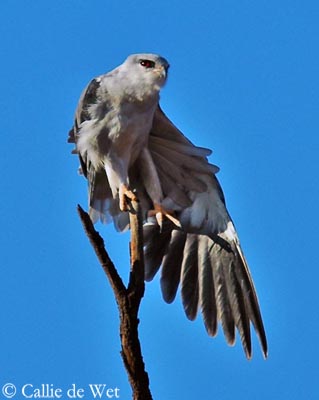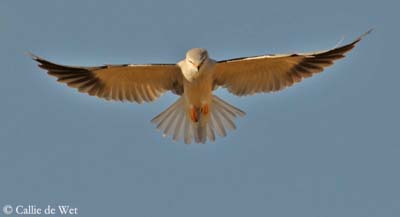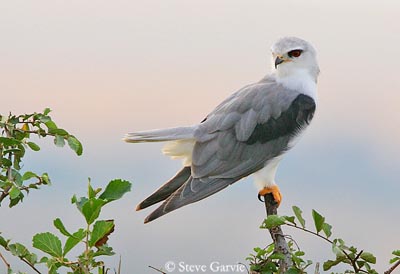
Black-winged Kite
Elanus caeruleus
Accipitriforme Order – Accipitridae Family
BIOMETRICS:
Length: 35-38 cm
Wingspan: 80-95 cm
Weight: 197-343 g
DESCRIPTION:
Black-winged Kite is grey and white with black shoulders and red eyes.
Upperparts are bluish-grey. Black wings coverts form a black shoulder patch. Central tail feathers are bluish-grey and outer tail feathers are white. It has long pointed wings and rounded tail.
Underparts are white. Outer primaries are black.
Head is white, with a small black mask around the eye. Bill is rather short, with hooked upper mandible. Bill is black with yellow cere. Eyes are dark red. Short bare legs and feet are yellow.
Both sexes are similar.
PROTECTION / THREATS / STATUS:
Black-winged Kite populations appear to increase in some areas, due to deforestation for agriculture, giving a suitable habitat to rodent populations, and of course, to Black-winged Kites which feed on them. This species was observed nesting in SW France in 1990 for the first time.
Fr: Elanion blanc
All : Gleitaar
Esp: Elanio Común
Ital: Nibbio bianco
Nd: Grijze Wouw
Russe: Дымчатый коршун
Sd: Svartvingad glada
Photographers:
Steve Garvie
RAINBIRDER Photo galleries
Callie de Wet
GALLERY
Didier Buysse
Vision d’Oiseaux
Text by Nicole Bouglouan
Sources:
HANDBOOK OF THE BIRDS OF THE WORLD Vol 2 by Josep del Hoyo-Andrew Elliot-Jordi Sargatal - Lynx Edicions - ISBN: 8487334156
THE HANDBOOK OF BIRD IDENTIFICATION FOR EUROPE AND THE WESTERN PALEARCTIC by Mark Beaman, Steve Madge - C.Helm - ISBN: 0713639601
BIRDS OF PREY OF AFRICA AND ITS ISLANDS by Alan and Meg Kemp - Struik Publishers - ISBN: 1770073698
GUIDE DES RAPACES DIURNES – Europe, Afrique du Nord et Moyen-Orient de Benny Génsbol – Delachaux et Niestlé – ISBN : 2603013270
ARKive (Christopher Parsons)
Pájaros de España (JL Beamonte)

Juvenile resembles adult, with rather sooty-grey shoulders, and reddish-brown wash on head and breast, and fine brown streaks on lower breast. Eyes are pale brown to brownish-orange.
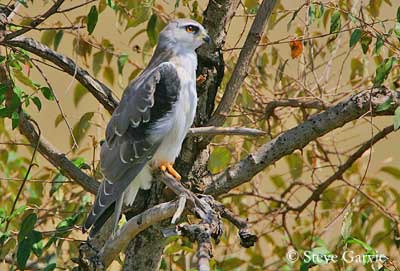
VOICE: SOUNDS BY XENO-CANTO
Black-winged Kite is usually silent, but it may utter some sounds, such as varied weak whistling calls: a melodious “weepweep”; a wailing whistle at nest; a “piii-uu” during displays; alarm calls are double whistles “plee-wit, plee-wit”. Other aspirated lower sounds may be heard. If it attacks other birds, it gives series of shrill whistles.
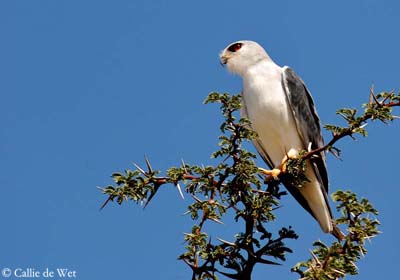
HABITAT:
Black-winged Kite breeds in savannahs, semi-desert grasslands, steppes and cultivated plains with thickets. In dry areas, it needs the vicinity of the water. It may be found from sea level to 2700 metres of elevation.
RANGE:
Black-winged Kite lives in sub-Saharan Africa, NW Africa, southern Asia, East Indies, Arabia and southern Europe. Widespread and locally common, this species is widely nomadic, according to the food resources such as rodent populations. It is very sedentary in the equatorial parts of its range.
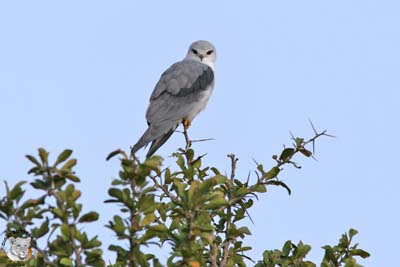
BEHAVIOUR:
Black-winged Kite perches on exposed places from which it hunts small rodents, birds, reptiles and large insects. It may hunt from a perch, but often by hovering in mid-air with skill and little effort. When a prey is selected, it drops silently onto it, feet-first, with wings in high V. It may perform some hovering pauses at intermediate heights, before to drop to ground level. Small preys are eaten while flying, and larger preys are brought to a branch or a rock. They usually hunt at dusk.
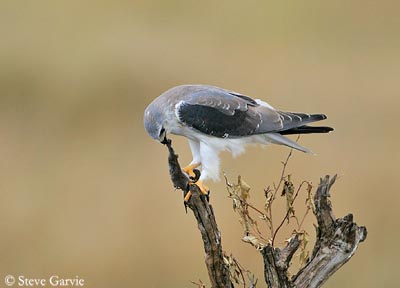

Courtship displays include fluttering flights while giving high, rasping calls, or wailing sounds. It may continue these flight displays by gliding to a future nest-site in a tree.
It roosts in trees, often in large flocks of up to 500 birds. Pairs remain together for most of the year, and remain usually relatively close to each other. Their range depends of food resources. Both mates circle very high above their territory. We can also see nuptial chasing and mutual soaring.
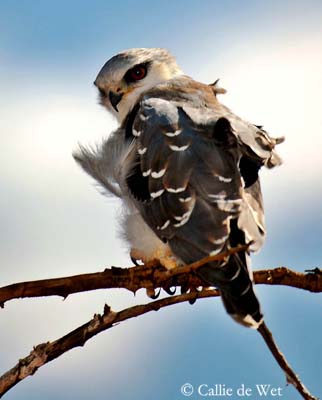
When perched, Black-winged Kite raises and lowers the tail very often. Maybe it is a form of display, but also when excited. It is the pre-copulation display.
Both parents are aggressive if an intruder disturbs the nest, and they strongly attack raptors and crows passing near by.
FLIGHT:
Black-winged Kite flies over the ground, sometimes hovering, and circling into the wind as a Kestrel. When it flies from perch to perch, it performs direct flights with measured wing beats.
During courtship displays, it flies with shallow, fluttering flight, and then, performs some glides. It also soars fast with V-shaped wings.

REPRODUCTION:
Black-winged Kites build the nest themselves, and they build a new nest each year in the same area, and even in the same tree.
Nest is a small structure made with thin twigs. It is a flat and loose structure. It is usually located in a large tree, often in a thorny one, at about 5 to 60 feet above the ground. If any tree is available, they may nest on rock ledges. Nest is built by both adults. Male brings most of the material, and female works it into the nest.
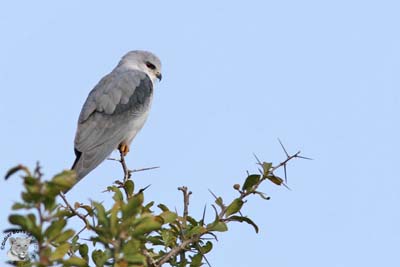
Female lays 3 to 5 eggs, at intervals of 2-3 days. Incubation lasts about 25 to 28 days, mainly by female, but male feeds her on or close to the nest during this period.
Eggs hatch at 2-3 days intervals, that means that a complete brood may take a week or more to hatch. Despite the wide variation in the size, older chicks are rarely aggressive to the younger.
Young reach their plumage at about 3 weeks of age. They may fly at 30 to 35 days when food is abundant. Young return to the nest between their flights, and are fed by adults away from the nest.
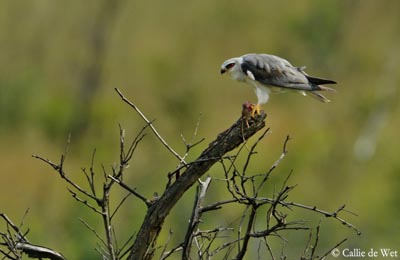
Male brings prey to female which remains on the nest, tending the young. Female alone feeds them, male only brings preys to the nest, and they tear up themselves. Female feeds all the young, and does not favour the largest.
According to the food resources, Black-winged Kite pair may produce two broods within a season.
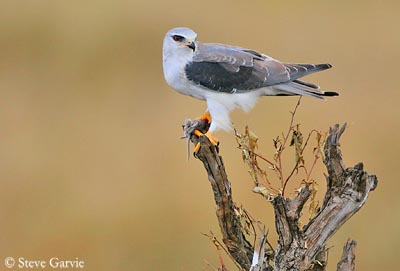
DIET:
Black-winged Kite feeds mainly on mammals as small rats. It also eats small ground birds and large insects such as grasshoppers and locusts. On Arabian coast, it feeds dead fish, lizards and offal.
